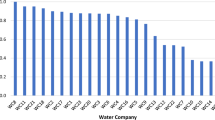Abstract
This paper adopts an ex-post regulatory impact assessment (RIA) to analyze the effects of Law no.194/2009 on public-private partnerships (PPP) in the water sector in Portugal. Although the water services have been improving concerning coverage and safety since 1990, any change in regulation can have both “positive and negative” consequences either for customers, providers or local governments. This context can provide the opportunity to observe a national experiment of regulatory reform and assess its outcomes based on the following multiple targets: (i) customer protection; (ii) governance; (iii) financial, infrastructure and operational sustainability; and (iv) environmental improvement. To evaluate the impact of this legal reform, three steps were considered: (i) the status quo, scenarios and perspective; (ii) assessment; and (iii) consultation. Additionally, two aid methods were used: (i) expert opinions (Delphi) and (ii) multicriteria decision modelling method (TOPSIS) based on similarity distance to ideal solution. In fact, Law no.194/2009 reduced the gap in terms of performance between the concessions, but amplified the contrasts when all perspectives are compared. Regarding policy objectives, the major gap to overcome in a possible review of this legal framework is linked to the “economic-financial, operational and infrastructural sustainability objective”. Failures in any of these aspects can result in an ongoing PPP not meeting customer, municipality and concessionaire’s expectations.


Similar content being viewed by others
Abbreviations
- IED:
-
Integral Euclidean distance
- IQR:
-
Interquartile Range
- MAUT:
-
Multi-attribute utility theory
- MCDA:
-
Multicriteria decision analysis
- NIS:
-
Negative ideal solution
- PIS:
-
Positive ideal solution
- PPP:
-
Public-private partnership
- PWS:
-
Portuguese water sector
- RIA:
-
Regulatory impact assessment
- TOPSIS:
-
Technique for order preference by similarity to ideal solution
- WWU:
-
Water and wastewater utilities
References
Afshar A, Mariño MA, Saadatpour M, Afshar A (2011) Fuzzy TOPSIS multi-criteria decision analysis applied to Karun reservoirs system. Water Resour Manag 25:545–563
Araral E, Wang Y (2013) Water governance 2.0: a review and second generation research agenda. Water Resour Manag 27:3945–3957
Belton V, Stewart TJ (2002) Multiple criteria decision analysis: an integrated approach. Kluwer Academic Publishers, Norwell, p 400
Bottomley PA, Doyle JR (2001) A comparison of three weight elicitation methods: good, better, and best. Int J Manag Sci 29:553–560
Boulkedid R, Abdoul H, Loustau M et al (2011) Using and reporting the Delphi method for selecting healthcare quality indicators: a systematic review. PLoS One 6(6):e20476
Brown AC, Stern J, Tenenbaum B, Gencer D (2006) Evaluating infrastructure regulatory systems. WB, Washington DC
Carvalho BE, Marques RC, Netto OC (2017) Regulatory impact assessment ( RIA ): from the state of art until conceptual and framework proposal model. Int J Confl Manag 6:111–126
Dunn WN (1994) Public policy analysis — an introduction. Prentice-Hall, Englewood Cliffs
EMF (2008) Research study on incorporation of regulatory impact assessment within the Egyptian business regulatory environment. International Development Research Centre. http://www.mof.gov.eg/MOFGallerySource/English/SME/Research_studies/33.pdf. Accessed 3 July 2016
ERSAR (2011) Guia de Avaliação da qualidade dos serviços se Águas e Resíduos prestados aos utilizadores. http://www.ersar.pt/pt/publicacoes/publicacoes-tecnicas/guias. Accessed 3 Jan 2016
French S (2011) Expert judgement, meta-analysis and participatory risk analysis. Report. University of Warwick
Gordon TJ (1994) The Delphi method. United Nations University, USA
Greco S, Matthias E, Figueira JR (eds) (2015) Multiple criteria decision analysis: state of the art surveys. Springer, Berlin
Hasson F, Keeney S (2011) Enhancing rigour in the Delphi technique research. Technology Forecasting Social Change 78:1695–1704
Jadidi O, Hong TS, Firouzi F (2009) TOPSIS extension for multi-objective supplier selection problem under price breaks. International Journal Management Science Engineering Management 4(3):217–229
Lima VF (2010) A Avaliação de Impacto Regulatório e sua aplicação no Brasil. Dissertation, Federal University of Rio de Janeiro
Marques RC, Berg S (2010) Revisiting the strengths and limitations of regulatory contracts in infrastructure industries. J Infrastruct Syst 16:334–342
Massarutto A, Antonioli B, Ermano P (2013) Assessing the impact of water service regulatory reforms in Italy: a multidimensional approach. Water Policy 15:1046–1063
Mendonça EC (2009) Metodologia para avaliação de desempenho de sistemas de drenagem urbana. Universidade de Brasília, Brasilia, p 195
Meng F, Fu G, Butler D (2016) Water quality permitting: from end-of-pipe to operational strategies. Water Res 101:114–126
Miser H, Quade E (1985) Handbook of systems analysis: overview of uses, procedures, applications and practices. John Wiley & Sons, Chichester
Montibeller G, von Winterfeldt D (2015) Cognitive and motivational biases in decision and risk analysis. Risk Anal 35:1230–1251
Mutikanga HE, Sharma SK, Vairavamoorthy K (2011) Multi-criteria decision analysis: a strategic planning tool for water loss management. Water Resour Manag 25:3947–3969
Pinto FS, da Cruz NF, Marques RC (2015) Contracting water services with public and private partners: a case study approach. J Water Supply Res Technol 64:194–210
Rowe G, Wright G (1999) The Delphi technique as a forecasting tool: issues and analysis. International Journal Forecast 15:353–375
Roy B, Słowiński R (2013) Questions guiding the choice of a multicriteria decision aiding method. European Journal Decision Process 1:69–97
Shih HS, Shyur HJ, Lee ES (2007) An extension of TOPSIS for group decision making. Mathematic Computing Model 45:801–813
Spiller M, McIntosh BS, Seaton RAF, Jeffrey PJ (2015) Integrating process and factor understanding of environmental innovation by water utilities. Water Resour Manag 29:1979–1993
von der Gracht HA (2012) Consensus measurement in Delphi studies. Review and implications for future quality assurance. Technology Forecast Social Change 79:1525–1536
Wright JTC, Giovinazzo RA (2000) Delphi: a tool to support prospective planning. Research in Business Administration 1:2–16
Author information
Authors and Affiliations
Corresponding author
Appendices
Appendix 1
Appendix 2
Appendix 3
Appendix 4
Appendix 5
Appendix 6
Appendix 7
Appendix 8
Rights and permissions
About this article
Cite this article
de Carvalho, B.E., Marques, R.C. & Netto, O.C. Regulatory Impact Assessment (RIA): an Ex-Post Analysis of Water Services by the Legal Review in Portugal. Water Resour Manage 32, 675–699 (2018). https://doi.org/10.1007/s11269-017-1833-0
Received:
Accepted:
Published:
Issue Date:
DOI: https://doi.org/10.1007/s11269-017-1833-0












